ANALYSIS OF FOOD AND FOOD PRODUCTS •

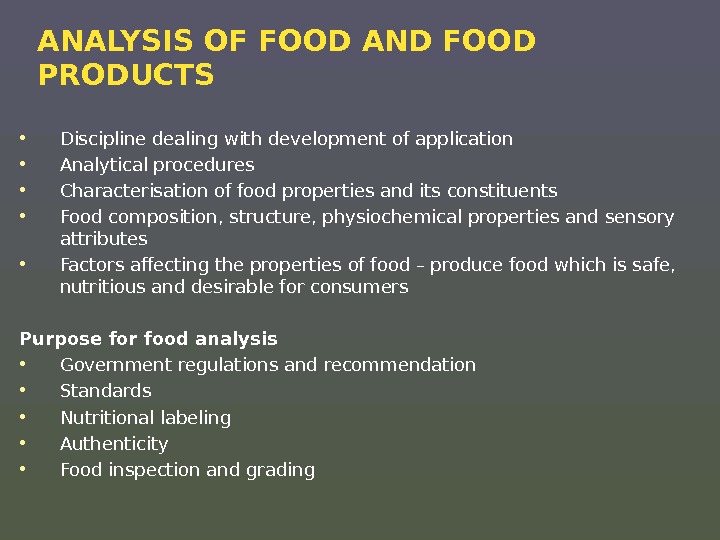
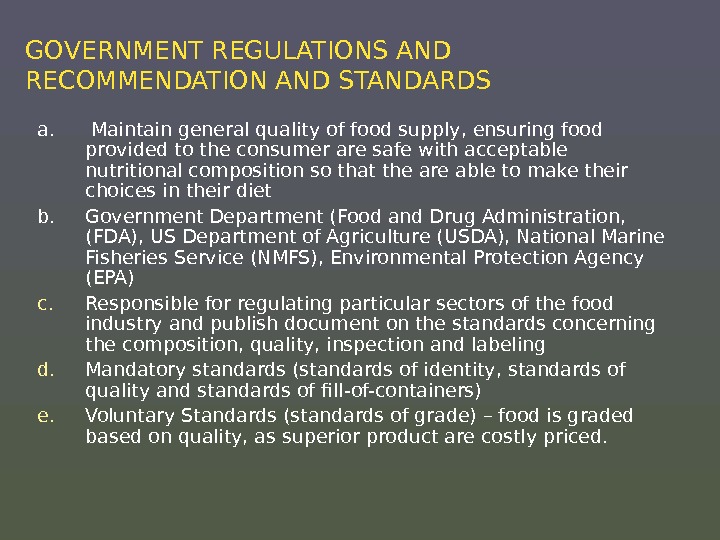
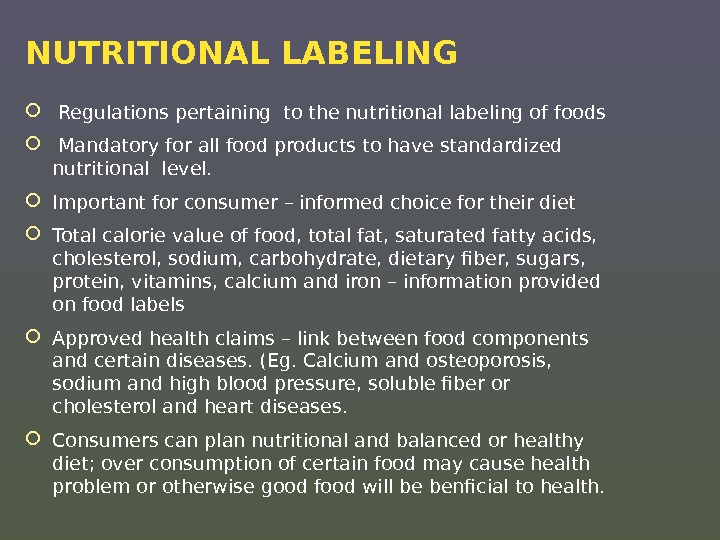
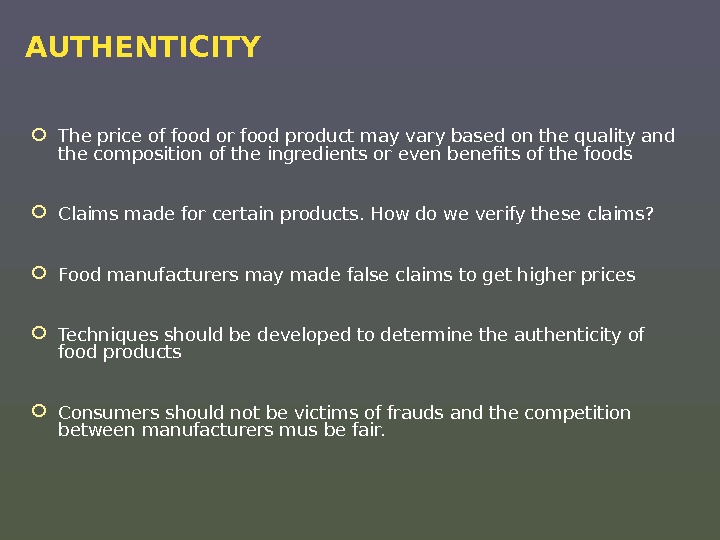
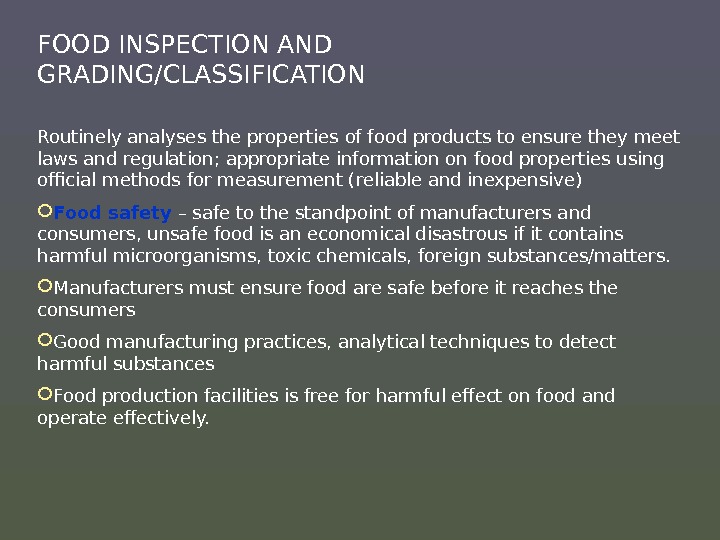
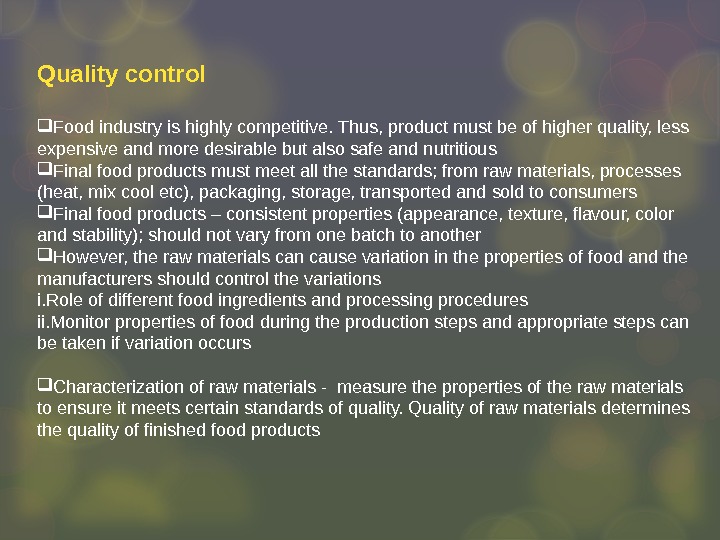
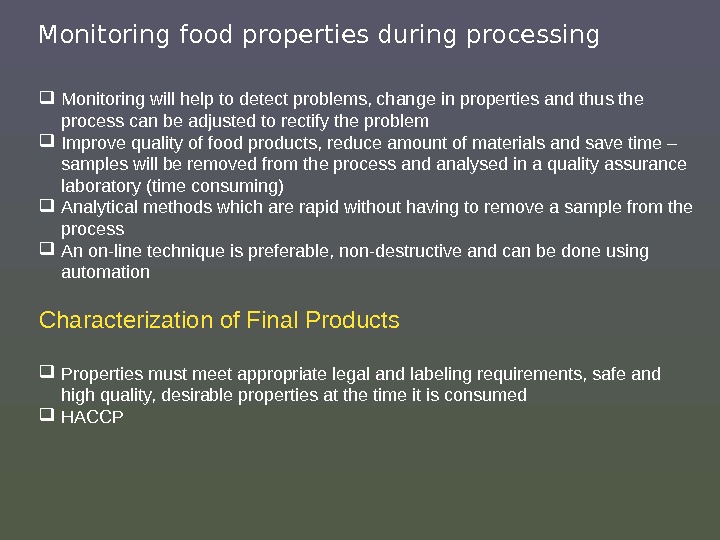
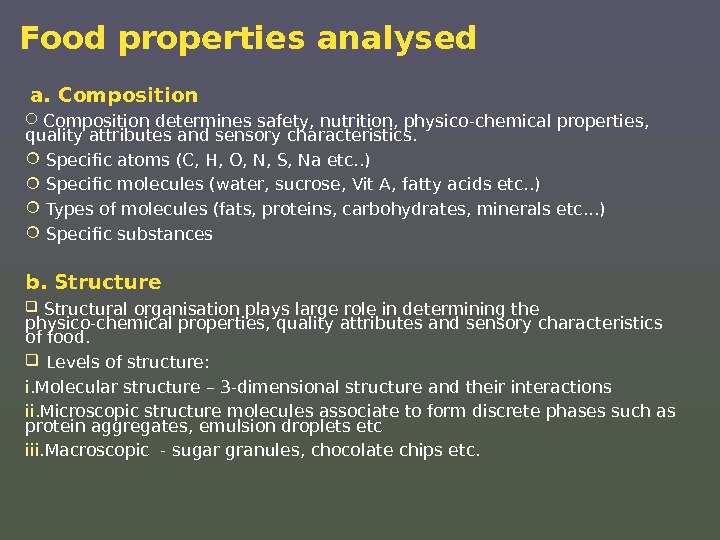
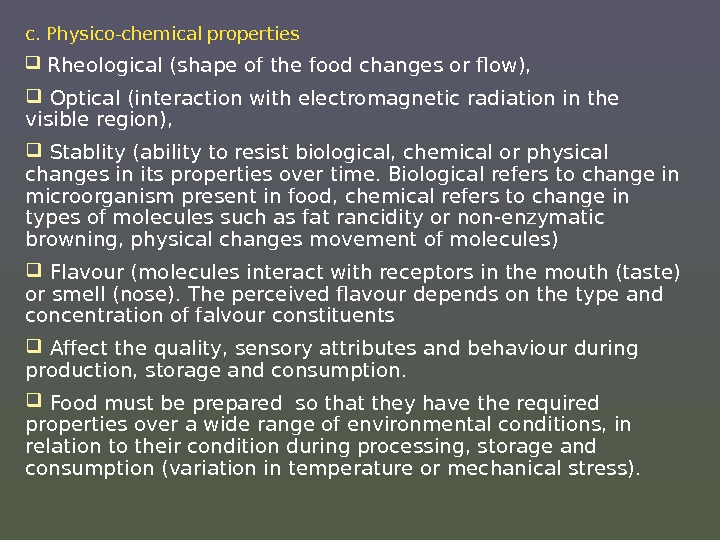
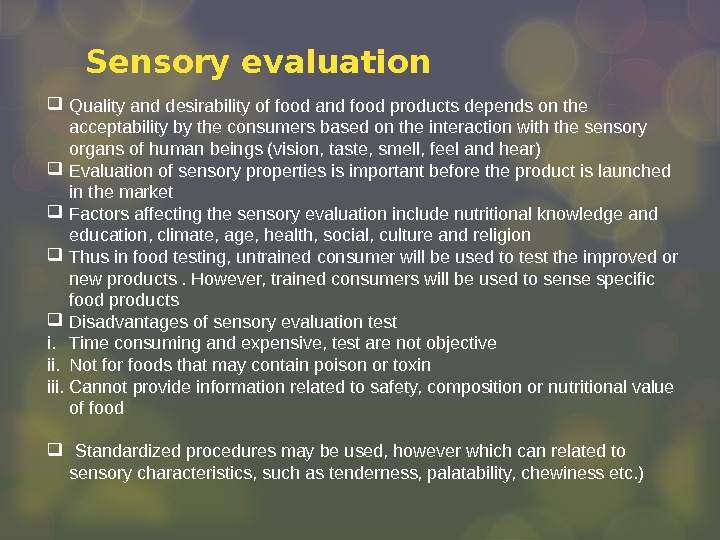

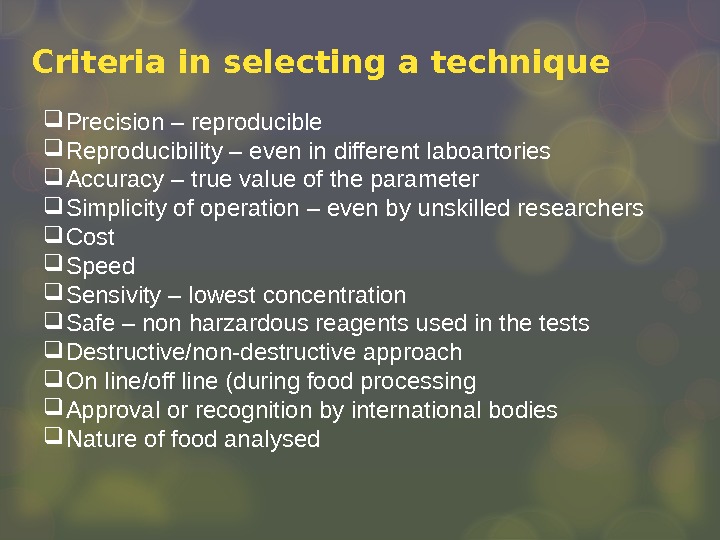

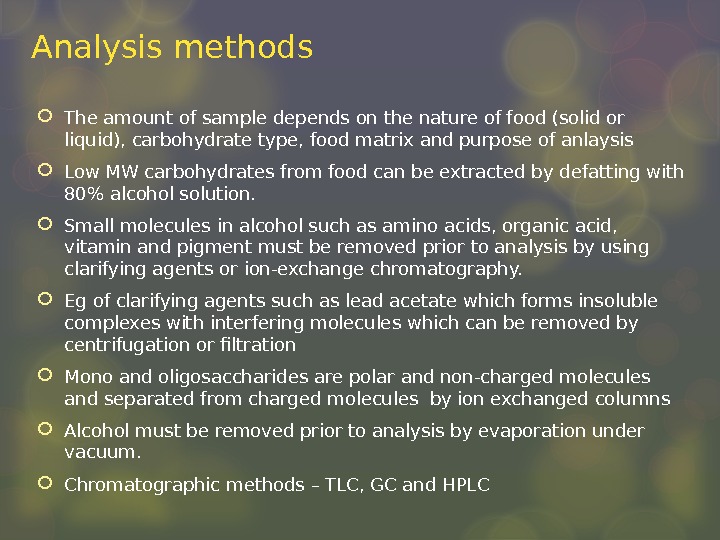
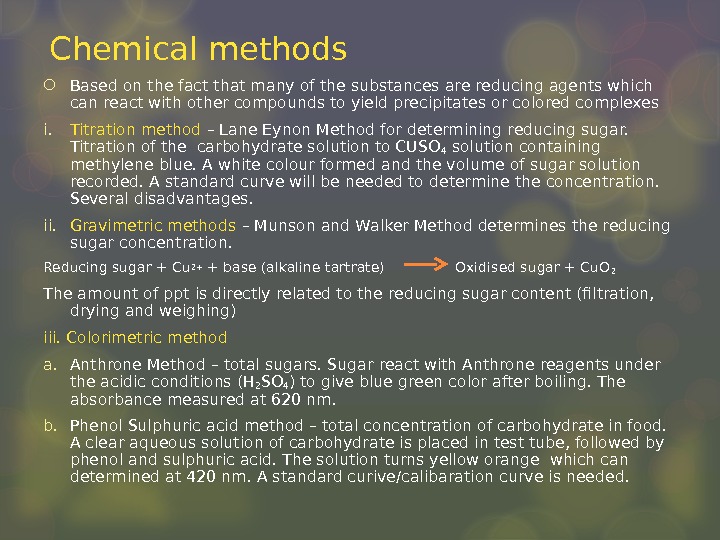

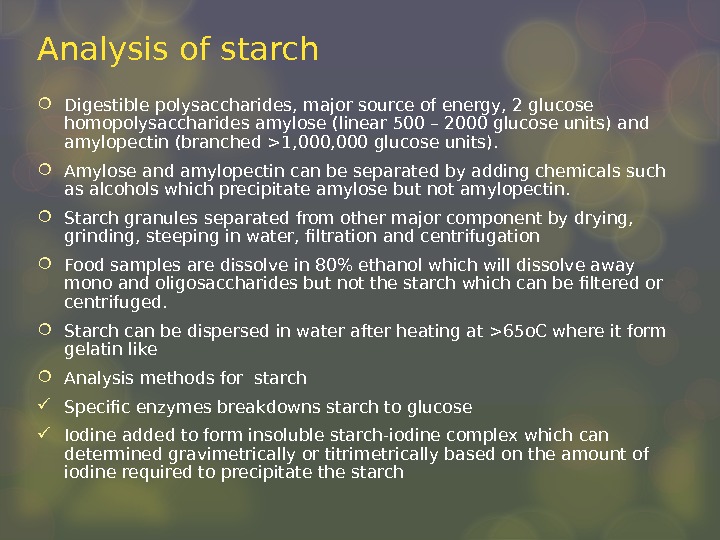
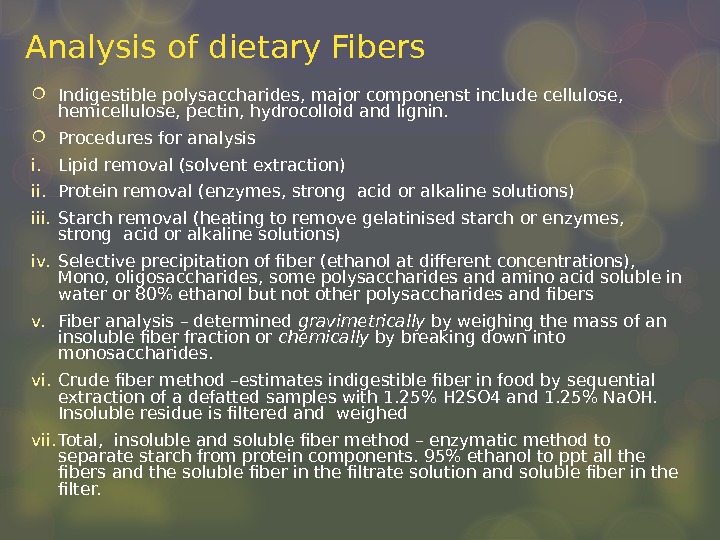
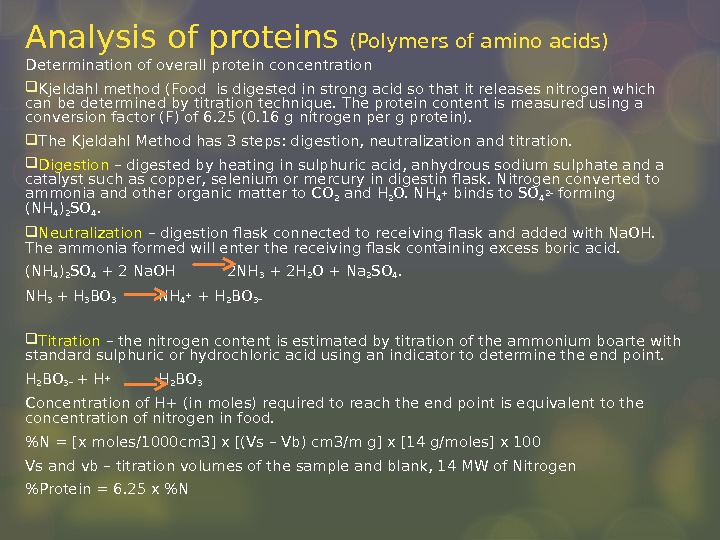
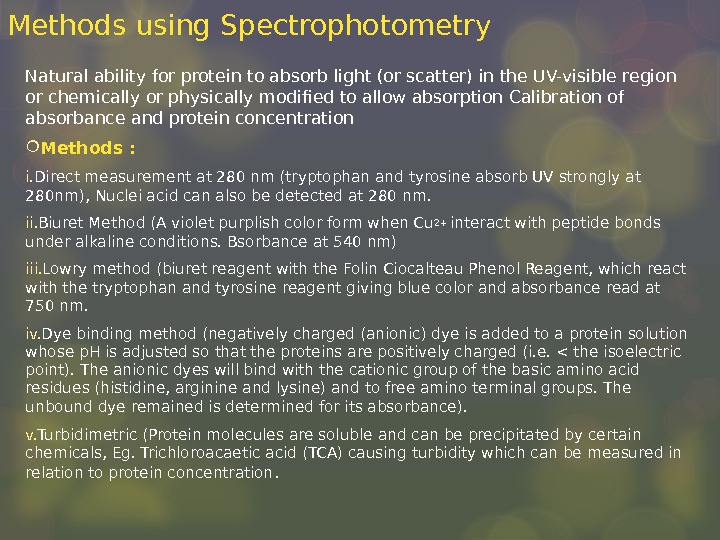
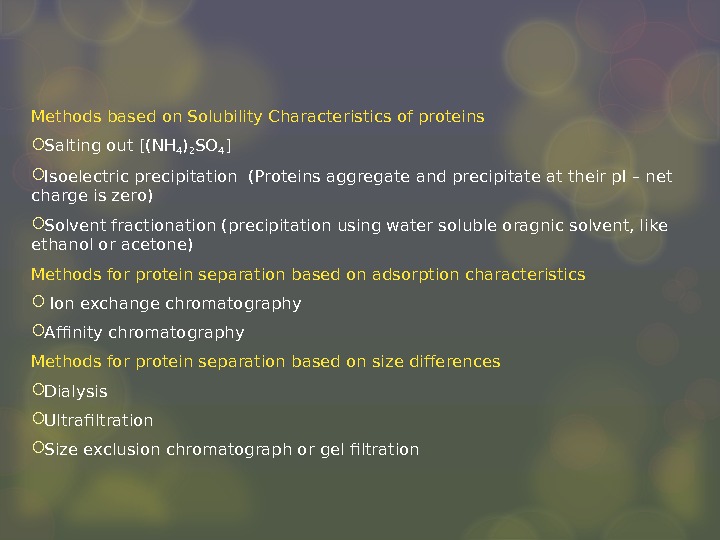

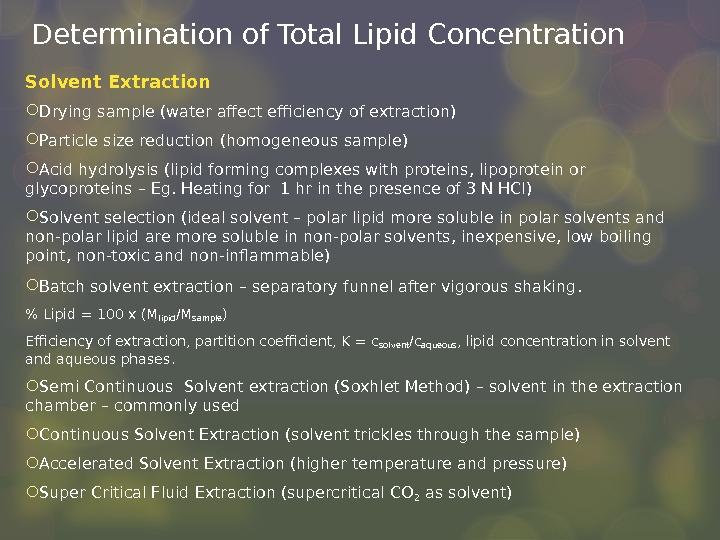
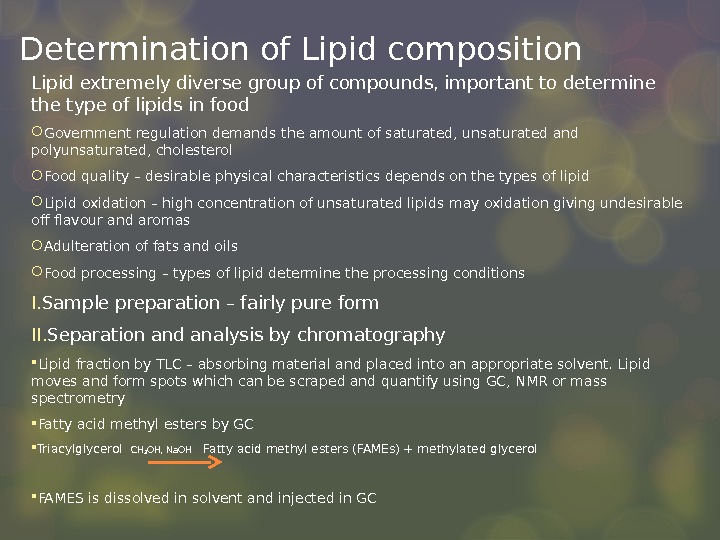
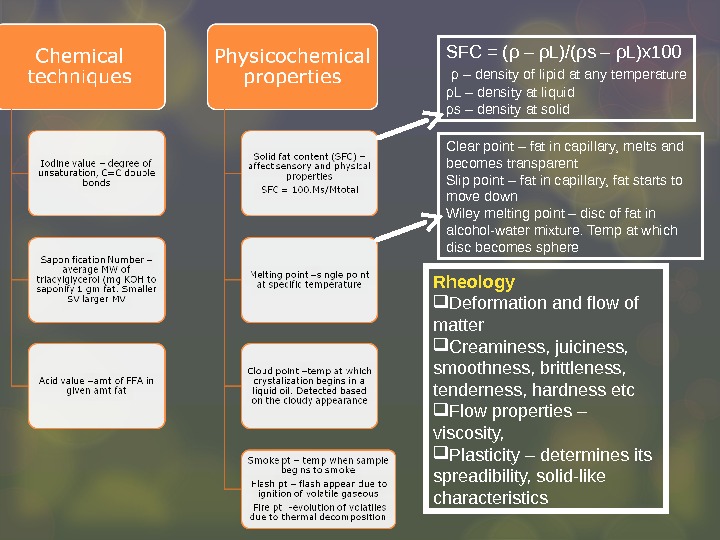
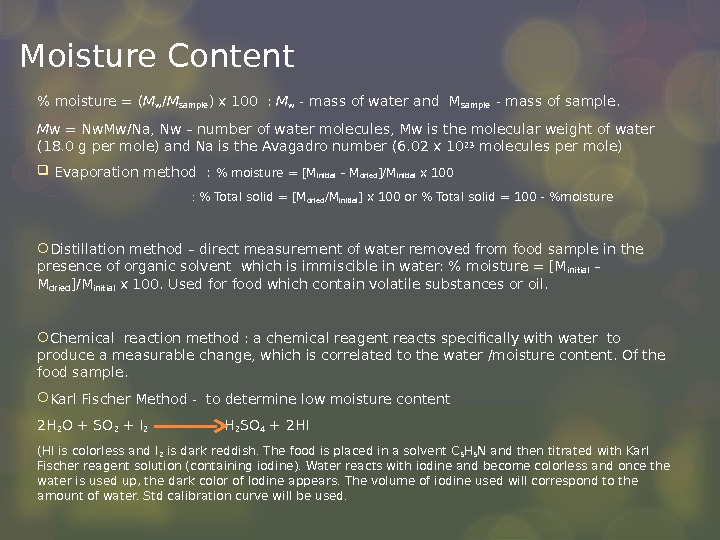
- Размер: 1.3 Mегабайта
- Количество слайдов: 26
Описание презентации ANALYSIS OF FOOD AND FOOD PRODUCTS • по слайдам
 ANALYSIS OF FOOD AND FOOD PRODUCTS • Discipline dealing with development of application • Analytical procedures • Characterisation of food properties and its constituents • Food composition, structure, physiochemical properties and sensory attributes • Factors affecting the properties of food – produce food which is safe, nutritious and desirable for consumers Purpose for food analysis • Government regulations and recommendation • Standards • Nutritional labeling • Authenticity • Food inspection and grading
ANALYSIS OF FOOD AND FOOD PRODUCTS • Discipline dealing with development of application • Analytical procedures • Characterisation of food properties and its constituents • Food composition, structure, physiochemical properties and sensory attributes • Factors affecting the properties of food – produce food which is safe, nutritious and desirable for consumers Purpose for food analysis • Government regulations and recommendation • Standards • Nutritional labeling • Authenticity • Food inspection and grading
 GOVERNMENT REGULATIONS AND RECOMMENDATION AND STANDARDS a. Maintain general quality of food supply, ensuring food provided to the consumer are safe with acceptable nutritional composition so that the are able to make their choices in their diet b. Government Department (Food and Drug Administration, (FDA), US Department of Agriculture (USDA), National Marine Fisheries Service (NMFS), Environmental Protection Agency (EPA) c. Responsible for regulating particular sectors of the food industry and publish document on the standards concerning the composition, quality, inspection and labeling d. Mandatory standards (standards of identity, standards of quality and standards of fill-of-containers) e. Voluntary Standards (standards of grade) – food is graded based on quality, as superior product are costly priced.
GOVERNMENT REGULATIONS AND RECOMMENDATION AND STANDARDS a. Maintain general quality of food supply, ensuring food provided to the consumer are safe with acceptable nutritional composition so that the are able to make their choices in their diet b. Government Department (Food and Drug Administration, (FDA), US Department of Agriculture (USDA), National Marine Fisheries Service (NMFS), Environmental Protection Agency (EPA) c. Responsible for regulating particular sectors of the food industry and publish document on the standards concerning the composition, quality, inspection and labeling d. Mandatory standards (standards of identity, standards of quality and standards of fill-of-containers) e. Voluntary Standards (standards of grade) – food is graded based on quality, as superior product are costly priced.
 NUTRITIONAL LABELING Regulations pertaining to the nutritional labeling of foods Mandatory for all food products to have standardized nutritional level. Important for consumer – informed choice for their diet Total calorie value of food, total fat, saturated fatty acids, cholesterol, sodium, carbohydrate, dietary fiber, sugars, protein, vitamins, calcium and iron – information provided on food labels Approved health claims – link between food components and certain diseases. (Eg. Calcium and osteoporosis, sodium and high blood pressure, soluble fiber or cholesterol and heart diseases. Consumers can plan nutritional and balanced or healthy diet; over consumption of certain food may cause health problem or otherwise good food will be benficial to health.
NUTRITIONAL LABELING Regulations pertaining to the nutritional labeling of foods Mandatory for all food products to have standardized nutritional level. Important for consumer – informed choice for their diet Total calorie value of food, total fat, saturated fatty acids, cholesterol, sodium, carbohydrate, dietary fiber, sugars, protein, vitamins, calcium and iron – information provided on food labels Approved health claims – link between food components and certain diseases. (Eg. Calcium and osteoporosis, sodium and high blood pressure, soluble fiber or cholesterol and heart diseases. Consumers can plan nutritional and balanced or healthy diet; over consumption of certain food may cause health problem or otherwise good food will be benficial to health.
 AUTHENTICITY The price of food or food product may vary based on the quality and the composition of the ingredients or even benefits of the foods Claims made for certain products. How do we verify these claims? Food manufacturers may made false claims to get higher prices Techniques should be developed to determine the authenticity of food products Consumers should not be victims of frauds and the competition between manufacturers mus be fair.
AUTHENTICITY The price of food or food product may vary based on the quality and the composition of the ingredients or even benefits of the foods Claims made for certain products. How do we verify these claims? Food manufacturers may made false claims to get higher prices Techniques should be developed to determine the authenticity of food products Consumers should not be victims of frauds and the competition between manufacturers mus be fair.
 FOOD INSPECTION AND GRADING/CLASSIFICATION Routinely analyses the properties of food products to ensure they meet laws and regulation; appropriate information on food properties using official methods for measurement (reliable and inexpensive) Food safety – safe to the standpoint of manufacturers and consumers, unsafe food is an economical disastrous if it contains harmful microorganisms, toxic chemicals, foreign substances/matters. Manufacturers must ensure food are safe before it reaches the consumers Good manufacturing practices, analytical techniques to detect harmful substances Food production facilities is free for harmful effect on food and operate effectively.
FOOD INSPECTION AND GRADING/CLASSIFICATION Routinely analyses the properties of food products to ensure they meet laws and regulation; appropriate information on food properties using official methods for measurement (reliable and inexpensive) Food safety – safe to the standpoint of manufacturers and consumers, unsafe food is an economical disastrous if it contains harmful microorganisms, toxic chemicals, foreign substances/matters. Manufacturers must ensure food are safe before it reaches the consumers Good manufacturing practices, analytical techniques to detect harmful substances Food production facilities is free for harmful effect on food and operate effectively.
 Quality control Food industry is highly competitive. Thus, product must be of higher quality, less expensive and more desirable but also safe and nutritious Final food products must meet all the standards; from raw materials, processes (heat, mix cool etc), packaging, storage, transported and sold to consumers Final food products – consistent properties (appearance, texture, flavour, color and stability); should not vary from one batch to another However, the raw materials can cause variation in the properties of food and the manufacturers should control the variations i. Role of different food ingredients and processing procedures ii. Monitor properties of food during the production steps and appropriate steps can be taken if variation occurs Characterization of raw materials — measure the properties of the raw materials to ensure it meets certain standards of quality. Quality of raw materials determines the quality of finished food products
Quality control Food industry is highly competitive. Thus, product must be of higher quality, less expensive and more desirable but also safe and nutritious Final food products must meet all the standards; from raw materials, processes (heat, mix cool etc), packaging, storage, transported and sold to consumers Final food products – consistent properties (appearance, texture, flavour, color and stability); should not vary from one batch to another However, the raw materials can cause variation in the properties of food and the manufacturers should control the variations i. Role of different food ingredients and processing procedures ii. Monitor properties of food during the production steps and appropriate steps can be taken if variation occurs Characterization of raw materials — measure the properties of the raw materials to ensure it meets certain standards of quality. Quality of raw materials determines the quality of finished food products
 Monitoring food properties during processing Monitoring will help to detect problems, change in properties and thus the process can be adjusted to rectify the problem Improve quality of food products, reduce amount of materials and save time – samples will be removed from the process and analysed in a quality assurance laboratory (time consuming) Analytical methods which are rapid without having to remove a sample from the process An on-line technique is preferable, non-destructive and can be done using automation Characterization of Final Products Properties must meet appropriate legal and labeling requirements, safe and high quality, desirable properties at the time it is consumed HACCP
Monitoring food properties during processing Monitoring will help to detect problems, change in properties and thus the process can be adjusted to rectify the problem Improve quality of food products, reduce amount of materials and save time – samples will be removed from the process and analysed in a quality assurance laboratory (time consuming) Analytical methods which are rapid without having to remove a sample from the process An on-line technique is preferable, non-destructive and can be done using automation Characterization of Final Products Properties must meet appropriate legal and labeling requirements, safe and high quality, desirable properties at the time it is consumed HACCP
 Food properties analysed a. Composition determines safety, nutrition, physico-chemical properties, quality attributes and sensory characteristics. Specific atoms (C, H, O, N, S, Na etc. . ) Specific molecules (water, sucrose, Vit A, fatty acids etc. . ) Types of molecules (fats, proteins, carbohydrates, minerals etc…) Specific substances b. Structure Structural organisation plays large role in determining the physico-chemical properties, quality attributes and sensory characteristics of food. Levels of structure: i. Molecular structure – 3 -dimensional structure and their interactions ii. Microscopic structure molecules associate to form discrete phases such as protein aggregates, emulsion droplets etc iii. Macroscopic — sugar granules, chocolate chips etc.
Food properties analysed a. Composition determines safety, nutrition, physico-chemical properties, quality attributes and sensory characteristics. Specific atoms (C, H, O, N, S, Na etc. . ) Specific molecules (water, sucrose, Vit A, fatty acids etc. . ) Types of molecules (fats, proteins, carbohydrates, minerals etc…) Specific substances b. Structure Structural organisation plays large role in determining the physico-chemical properties, quality attributes and sensory characteristics of food. Levels of structure: i. Molecular structure – 3 -dimensional structure and their interactions ii. Microscopic structure molecules associate to form discrete phases such as protein aggregates, emulsion droplets etc iii. Macroscopic — sugar granules, chocolate chips etc.
 c. Physico-chemical properties Rheological (shape of the food changes or flow), Optical (interaction with electromagnetic radiation in the visible region), Stablity (ability to resist biological, chemical or physical changes in its properties over time. Biological refers to change in microorganism present in food, chemical refers to change in types of molecules such as fat rancidity or non-enzymatic browning, physical changes movement of molecules) Flavour (molecules interact with receptors in the mouth (taste) or smell (nose). The perceived flavour depends on the type and concentration of falvour constituents Affect the quality, sensory attributes and behaviour during production, storage and consumption. Food must be prepared so that they have the required properties over a wide range of environmental conditions, in relation to their condition during processing, storage and consumption (variation in temperature or mechanical stress).
c. Physico-chemical properties Rheological (shape of the food changes or flow), Optical (interaction with electromagnetic radiation in the visible region), Stablity (ability to resist biological, chemical or physical changes in its properties over time. Biological refers to change in microorganism present in food, chemical refers to change in types of molecules such as fat rancidity or non-enzymatic browning, physical changes movement of molecules) Flavour (molecules interact with receptors in the mouth (taste) or smell (nose). The perceived flavour depends on the type and concentration of falvour constituents Affect the quality, sensory attributes and behaviour during production, storage and consumption. Food must be prepared so that they have the required properties over a wide range of environmental conditions, in relation to their condition during processing, storage and consumption (variation in temperature or mechanical stress).
 Sensory evaluation Quality and desirability of food and food products depends on the acceptability by the consumers based on the interaction with the sensory organs of human beings (vision, taste, smell, feel and hear) Evaluation of sensory properties is important before the product is launched in the market Factors affecting the sensory evaluation include nutritional knowledge and education, climate, age, health, social, culture and religion Thus in food testing, untrained consumer will be used to test the improved or new products. However, trained consumers will be used to sense specific food products Disadvantages of sensory evaluation test i. Time consuming and expensive, test are not objective ii. Not for foods that may contain poison or toxin iii. Cannot provide information related to safety, composition or nutritional value of food Standardized procedures may be used, however which can related to sensory characteristics, such as tenderness, palatability, chewiness etc. )
Sensory evaluation Quality and desirability of food and food products depends on the acceptability by the consumers based on the interaction with the sensory organs of human beings (vision, taste, smell, feel and hear) Evaluation of sensory properties is important before the product is launched in the market Factors affecting the sensory evaluation include nutritional knowledge and education, climate, age, health, social, culture and religion Thus in food testing, untrained consumer will be used to test the improved or new products. However, trained consumers will be used to sense specific food products Disadvantages of sensory evaluation test i. Time consuming and expensive, test are not objective ii. Not for foods that may contain poison or toxin iii. Cannot provide information related to safety, composition or nutritional value of food Standardized procedures may be used, however which can related to sensory characteristics, such as tenderness, palatability, chewiness etc. )
 Choosing an Analytical Technique The choice depends on : Types of food to be analysed The reasons for carrying out the analysis Sources; Books (Introduction to Food Analysis, S. S. Nielsen 1998, Aspen Publisher) Official Methods of Analysis Eg. Association of the Official Analytical Chemists (AOAC) and American Oil Chemists Society (AOCS) Journals Equipment and reagent suppliers Internet
Choosing an Analytical Technique The choice depends on : Types of food to be analysed The reasons for carrying out the analysis Sources; Books (Introduction to Food Analysis, S. S. Nielsen 1998, Aspen Publisher) Official Methods of Analysis Eg. Association of the Official Analytical Chemists (AOAC) and American Oil Chemists Society (AOCS) Journals Equipment and reagent suppliers Internet
 Criteria in selecting a technique Precision – reproducible Reproducibility – even in different laboartories Accuracy – true value of the parameter Simplicity of operation – even by unskilled researchers Cost Speed Sensivity – lowest concentration Safe – non harzardous reagents used in the tests Destructive/non-destructive approach On line/off line (during food processing Approval or recognition by international bodies Nature of food analysed
Criteria in selecting a technique Precision – reproducible Reproducibility – even in different laboartories Accuracy – true value of the parameter Simplicity of operation – even by unskilled researchers Cost Speed Sensivity – lowest concentration Safe – non harzardous reagents used in the tests Destructive/non-destructive approach On line/off line (during food processing Approval or recognition by international bodies Nature of food analysed
 Analysis of carbohydrates Carbohydrates may be present as isolated molecules but can also be associated to other molecules Individual molecules – monosaccharides, oligosaccharides or polysaccharides Covalently attached to proteins – glycoproteins Attached to lipids — glycolipids Digestible carbohydrates are source of energy and indigestable carbohydrates are known as dietery fibers Contribute to sweetness, appearance, texture in foods Concentration of carbohydrates in food is important because: i. Standards of identity (government regulations) ii. Nutritinal labeling iii. Detection of adulteration iv. Food quality v. Economu vi. Food processing
Analysis of carbohydrates Carbohydrates may be present as isolated molecules but can also be associated to other molecules Individual molecules – monosaccharides, oligosaccharides or polysaccharides Covalently attached to proteins – glycoproteins Attached to lipids — glycolipids Digestible carbohydrates are source of energy and indigestable carbohydrates are known as dietery fibers Contribute to sweetness, appearance, texture in foods Concentration of carbohydrates in food is important because: i. Standards of identity (government regulations) ii. Nutritinal labeling iii. Detection of adulteration iv. Food quality v. Economu vi. Food processing
 Analysis methods The amount of sample depends on the nature of food (solid or liquid), carbohydrate type, food matrix and purpose of anlaysis Low MW carbohydrates from food can be extracted by defatting with 80% alcohol solution. Small molecules in alcohol such as amino acids, organic acid, vitamin and pigment must be removed prior to analysis by using clarifying agents or ion-exchange chromatography. Eg of clarifying agents such as lead acetate which forms insoluble complexes with interfering molecules which can be removed by centrifugation or filtration Mono and oligosaccharides are polar and non-charged molecules and separated from charged molecules by ion exchanged columns Alcohol must be removed prior to analysis by evaporation under vacuum. Chromatographic methods – TLC, GC and HPL
Analysis methods The amount of sample depends on the nature of food (solid or liquid), carbohydrate type, food matrix and purpose of anlaysis Low MW carbohydrates from food can be extracted by defatting with 80% alcohol solution. Small molecules in alcohol such as amino acids, organic acid, vitamin and pigment must be removed prior to analysis by using clarifying agents or ion-exchange chromatography. Eg of clarifying agents such as lead acetate which forms insoluble complexes with interfering molecules which can be removed by centrifugation or filtration Mono and oligosaccharides are polar and non-charged molecules and separated from charged molecules by ion exchanged columns Alcohol must be removed prior to analysis by evaporation under vacuum. Chromatographic methods – TLC, GC and HPL
 Chemical methods Based on the fact that many of the substances are reducing agents which can react with other compounds to yield precipitates or colored complexes i. Titration method – Lane Eynon Method for determining reducing sugar. Titration of the carbohydrate solution to CUSO 4 solution containing methylene blue. A white colour formed and the volume of sugar solution recorded. A standard curve will be needed to determine the concentration. Several disadvantages. ii. Gravimetric methods – Munson and Walker Method determines the reducing sugar concentration. Reducing sugar + Cu 2+ + base (alkaline tartrate) Oxidised sugar + Cu. O 2 The amount of ppt is directly related to the reducing sugar content (filtration, drying and weighing) iii. Colorimetric method a. Anthrone Method – total sugars. Sugar react with Anthrone reagents under the acidic conditions (H 2 SO 4 ) to give blue green color after boiling. The absorbance measured at 620 nm. b. Phenol Sulphuric acid method – total concentration of carbohydrate in food. A clear aqueous solution of carbohydrate is placed in test tube, followed by phenol and sulphuric acid. The solution turns yellow orange which can determined at 420 nm. A standard curive/calibaration curve is needed.
Chemical methods Based on the fact that many of the substances are reducing agents which can react with other compounds to yield precipitates or colored complexes i. Titration method – Lane Eynon Method for determining reducing sugar. Titration of the carbohydrate solution to CUSO 4 solution containing methylene blue. A white colour formed and the volume of sugar solution recorded. A standard curve will be needed to determine the concentration. Several disadvantages. ii. Gravimetric methods – Munson and Walker Method determines the reducing sugar concentration. Reducing sugar + Cu 2+ + base (alkaline tartrate) Oxidised sugar + Cu. O 2 The amount of ppt is directly related to the reducing sugar content (filtration, drying and weighing) iii. Colorimetric method a. Anthrone Method – total sugars. Sugar react with Anthrone reagents under the acidic conditions (H 2 SO 4 ) to give blue green color after boiling. The absorbance measured at 620 nm. b. Phenol Sulphuric acid method – total concentration of carbohydrate in food. A clear aqueous solution of carbohydrate is placed in test tube, followed by phenol and sulphuric acid. The solution turns yellow orange which can determined at 420 nm. A standard curive/calibaration curve is needed.
 Enzymatic Method Rapid, highly specific and sensitive to low concentration of carbohydrates in food (enzyme assay kits) Examples : i. D-Glucose/Fructose Glucose + Hexokinase + ATP Glucose-6 -phosphate (G 6 P) G 6 P + NADP+ Gluconate-6 phosphate + NADPH + H+ The amount of NADPH formed is proportional to the concentration of G 6 P and can be measured at 340 nm ii. Maltose/sucrose Maltose + H 2 O 2 -glucose Sucrose + H 2 O glucose + fructose Glucose and frictose can be measure using enzymes as above
Enzymatic Method Rapid, highly specific and sensitive to low concentration of carbohydrates in food (enzyme assay kits) Examples : i. D-Glucose/Fructose Glucose + Hexokinase + ATP Glucose-6 -phosphate (G 6 P) G 6 P + NADP+ Gluconate-6 phosphate + NADPH + H+ The amount of NADPH formed is proportional to the concentration of G 6 P and can be measured at 340 nm ii. Maltose/sucrose Maltose + H 2 O 2 -glucose Sucrose + H 2 O glucose + fructose Glucose and frictose can be measure using enzymes as above
 Analysis of starch Digestible polysaccharides, major source of energy, 2 glucose homopolysaccharides amylose (linear 500 – 2000 glucose units) and amylopectin (branched >1, 000 glucose units). Amylose and amylopectin can be separated by adding chemicals such as alcohols which precipitate amylose but not amylopectin. Starch granules separated from other major component by drying, grinding, steeping in water, filtration and centrifugation Food samples are dissolve in 80% ethanol which will dissolve away mono and oligosaccharides but not the starch which can be filtered or centrifuged. Starch can be dispersed in water after heating at >65 o. C where it form gelatin like Analysis methods for starch Specific enzymes breakdowns starch to glucose Iodine added to form insoluble starch-iodine complex which can determined gravimetrically or titrimetrically based on the amount of iodine required to precipitate the starch
Analysis of starch Digestible polysaccharides, major source of energy, 2 glucose homopolysaccharides amylose (linear 500 – 2000 glucose units) and amylopectin (branched >1, 000 glucose units). Amylose and amylopectin can be separated by adding chemicals such as alcohols which precipitate amylose but not amylopectin. Starch granules separated from other major component by drying, grinding, steeping in water, filtration and centrifugation Food samples are dissolve in 80% ethanol which will dissolve away mono and oligosaccharides but not the starch which can be filtered or centrifuged. Starch can be dispersed in water after heating at >65 o. C where it form gelatin like Analysis methods for starch Specific enzymes breakdowns starch to glucose Iodine added to form insoluble starch-iodine complex which can determined gravimetrically or titrimetrically based on the amount of iodine required to precipitate the starch
 Analysis of dietary Fibers Indigestible polysaccharides, major componenst include cellulose, hemicellulose, pectin, hydrocolloid and lignin. Procedures for analysis i. Lipid removal (solvent extraction) ii. Protein removal (enzymes, strong acid or alkaline solutions) iii. Starch removal (heating to remove gelatinised starch or enzymes, strong acid or alkaline solutions) iv. Selective precipitation of fiber (ethanol at different concentrations), Mono, oligosaccharides, some polysaccharides and amino acid soluble in water or 80% ethanol but not other polysaccharides and fibers v. Fiber analysis – determined gravimetrically by weighing the mass of an insoluble fiber fraction or chemically by breaking down into monosaccharides. vi. Crude fiber method –estimates indigestible fiber in food by sequential extraction of a defatted samples with 1. 25% H 2 SO 4 and 1. 25% Na. OH. Insoluble residue is filtered and weighed vii. Total, insoluble and soluble fiber method – enzymatic method to separate starch from protein components. 95% ethanol to ppt all the fibers and the soluble fiber in the filtrate solution and soluble fiber in the filter.
Analysis of dietary Fibers Indigestible polysaccharides, major componenst include cellulose, hemicellulose, pectin, hydrocolloid and lignin. Procedures for analysis i. Lipid removal (solvent extraction) ii. Protein removal (enzymes, strong acid or alkaline solutions) iii. Starch removal (heating to remove gelatinised starch or enzymes, strong acid or alkaline solutions) iv. Selective precipitation of fiber (ethanol at different concentrations), Mono, oligosaccharides, some polysaccharides and amino acid soluble in water or 80% ethanol but not other polysaccharides and fibers v. Fiber analysis – determined gravimetrically by weighing the mass of an insoluble fiber fraction or chemically by breaking down into monosaccharides. vi. Crude fiber method –estimates indigestible fiber in food by sequential extraction of a defatted samples with 1. 25% H 2 SO 4 and 1. 25% Na. OH. Insoluble residue is filtered and weighed vii. Total, insoluble and soluble fiber method – enzymatic method to separate starch from protein components. 95% ethanol to ppt all the fibers and the soluble fiber in the filtrate solution and soluble fiber in the filter.
 Analysis of proteins (Polymers of amino acids) Determination of overall protein concentration Kjeldahl method (Food is digested in strong acid so that it releases nitrogen which can be determined by titration technique. The protein content is measured using a conversion factor (F) of 6. 25 (0. 16 g nitrogen per g protein). The Kjeldahl Method has 3 steps: digestion, neutralization and titration. Digestion – digested by heating in sulphuric acid, anhydrous sodium sulphate and a catalyst such as copper, selenium or mercury in digestin flask. Nitrogen converted to ammonia and other organic matter to CO 2 and H 2 O. NH 4 + binds to SO 4 2 — forming (NH 4 ) 2 SO 4. Neutralization – digestion flask connected to receiving flask and added with Na. OH. The ammonia formed will enter the receiving flask containing excess boric acid. (NH 4 ) 2 SO 4 + 2 Na. OH 2 NH 3 + 2 H 2 O + Na 2 SO 4. NH 3 + H 3 BO 3 NH 4 + + H 2 BO 3 _ Titration – the nitrogen content is estimated by titration of the ammonium boarte with standard sulphuric or hydrochloric acid using an indicator to determine the end point. H 2 BO 3 _ + H + H 2 BO 3 Concentration of H+ (in moles) required to reach the end point is equivalent to the concentration of nitrogen in food. %N = [x moles/1000 cm 3] x [(Vs – Vb) cm 3/m g] x [14 g/moles] x 100 Vs and vb – titration volumes of the sample and blank, 14 MW of Nitrogen %Protein = 6. 25 x %N
Analysis of proteins (Polymers of amino acids) Determination of overall protein concentration Kjeldahl method (Food is digested in strong acid so that it releases nitrogen which can be determined by titration technique. The protein content is measured using a conversion factor (F) of 6. 25 (0. 16 g nitrogen per g protein). The Kjeldahl Method has 3 steps: digestion, neutralization and titration. Digestion – digested by heating in sulphuric acid, anhydrous sodium sulphate and a catalyst such as copper, selenium or mercury in digestin flask. Nitrogen converted to ammonia and other organic matter to CO 2 and H 2 O. NH 4 + binds to SO 4 2 — forming (NH 4 ) 2 SO 4. Neutralization – digestion flask connected to receiving flask and added with Na. OH. The ammonia formed will enter the receiving flask containing excess boric acid. (NH 4 ) 2 SO 4 + 2 Na. OH 2 NH 3 + 2 H 2 O + Na 2 SO 4. NH 3 + H 3 BO 3 NH 4 + + H 2 BO 3 _ Titration – the nitrogen content is estimated by titration of the ammonium boarte with standard sulphuric or hydrochloric acid using an indicator to determine the end point. H 2 BO 3 _ + H + H 2 BO 3 Concentration of H+ (in moles) required to reach the end point is equivalent to the concentration of nitrogen in food. %N = [x moles/1000 cm 3] x [(Vs – Vb) cm 3/m g] x [14 g/moles] x 100 Vs and vb – titration volumes of the sample and blank, 14 MW of Nitrogen %Protein = 6. 25 x %N
 Methods using Spectrophotometry Natural ability for protein to absorb light (or scatter) in the UV-visible region or chemically or physically modified to allow absorption Calibration of absorbance and protein concentration Methods : i. Direct measurement at 280 nm (tryptophan and tyrosine absorb UV strongly at 280 nm), Nuclei acid can also be detected at 280 nm. ii. Biuret Method (A violet purplish color form when Cu 2+ interact with peptide bonds under alkaline conditions. Bsorbance at 540 nm) iii. Lowry method (biuret reagent with the Folin Ciocalteau Phenol Reagent, which react with the tryptophan and tyrosine reagent giving blue color and absorbance read at 750 nm. iv. Dye binding method (negatively charged (anionic) dye is added to a protein solution whose p. H is adjusted so that the proteins are positively charged (i. e. < the isoelectric point). The anionic dyes will bind with the cationic group of the basic amino acid residues (histidine, arginine and lysine) and to free amino terminal groups. The unbound dye remained is determined for its absorbance). v. Turbidimetric (Protein molecules are soluble and can be precipitated by certain chemicals, Eg. Trichloroacaetic acid (TCA) causing turbidity which can be measured in relation to protein concentration.
Methods using Spectrophotometry Natural ability for protein to absorb light (or scatter) in the UV-visible region or chemically or physically modified to allow absorption Calibration of absorbance and protein concentration Methods : i. Direct measurement at 280 nm (tryptophan and tyrosine absorb UV strongly at 280 nm), Nuclei acid can also be detected at 280 nm. ii. Biuret Method (A violet purplish color form when Cu 2+ interact with peptide bonds under alkaline conditions. Bsorbance at 540 nm) iii. Lowry method (biuret reagent with the Folin Ciocalteau Phenol Reagent, which react with the tryptophan and tyrosine reagent giving blue color and absorbance read at 750 nm. iv. Dye binding method (negatively charged (anionic) dye is added to a protein solution whose p. H is adjusted so that the proteins are positively charged (i. e. < the isoelectric point). The anionic dyes will bind with the cationic group of the basic amino acid residues (histidine, arginine and lysine) and to free amino terminal groups. The unbound dye remained is determined for its absorbance). v. Turbidimetric (Protein molecules are soluble and can be precipitated by certain chemicals, Eg. Trichloroacaetic acid (TCA) causing turbidity which can be measured in relation to protein concentration.
![Methods based on Solubility Characteristics of proteins Salting out [(NH 4 ) 2 SO 4 ] Methods based on Solubility Characteristics of proteins Salting out [(NH 4 ) 2 SO 4 ]](/docs//food_analysis_and_measurement_images/food_analysis_and_measurement_20.jpg) Methods based on Solubility Characteristics of proteins Salting out [(NH 4 ) 2 SO 4 ] Isoelectric precipitation (Proteins aggregate and precipitate at their p. I – net charge is zero) Solvent fractionation (precipitation using water soluble oragnic solvent, like ethanol or acetone) Methods for protein separation based on adsorption characteristics Ion exchange chromatography Affinity chromatography Methods for protein separation based on size differences Dialysis Ultrafiltration Size exclusion chromatograph or gel filtration
Methods based on Solubility Characteristics of proteins Salting out [(NH 4 ) 2 SO 4 ] Isoelectric precipitation (Proteins aggregate and precipitate at their p. I – net charge is zero) Solvent fractionation (precipitation using water soluble oragnic solvent, like ethanol or acetone) Methods for protein separation based on adsorption characteristics Ion exchange chromatography Affinity chromatography Methods for protein separation based on size differences Dialysis Ultrafiltration Size exclusion chromatograph or gel filtration
 Analysis of lipid Important properties of concern : Total lipid concentration Type of lipid Physicochemical properties of lipid (crystallization, melting point, rheology, density and color) Structural of lipid in food Properties of lipids in Food Soluble in organic solvents, triacylglycerol (95 -99%), diacylglycerol and monoacaylglycerol, FFA, phospholipid, sterols, caratenoids and Vit A & D) Triacyglycerols are ester of 3 FA and FA found in food vary in chain length, degree of unsaturation and position on the glycerol moiety Each fat has different lipid profiles which determines the nutritional and physicochemical properties Fat/oil/lipid – used interchangeably
Analysis of lipid Important properties of concern : Total lipid concentration Type of lipid Physicochemical properties of lipid (crystallization, melting point, rheology, density and color) Structural of lipid in food Properties of lipids in Food Soluble in organic solvents, triacylglycerol (95 -99%), diacylglycerol and monoacaylglycerol, FFA, phospholipid, sterols, caratenoids and Vit A & D) Triacyglycerols are ester of 3 FA and FA found in food vary in chain length, degree of unsaturation and position on the glycerol moiety Each fat has different lipid profiles which determines the nutritional and physicochemical properties Fat/oil/lipid – used interchangeably
 Determination of Total Lipid Concentration Solvent Extraction Drying sample (water affect efficiency of extraction) Particle size reduction (homogeneous sample) Acid hydrolysis (lipid forming complexes with proteins, lipoprotein or glycoproteins – Eg. Heating for 1 hr in the presence of 3 N HCl) Solvent selection (ideal solvent – polar lipid more soluble in polar solvents and non-polar lipid are more soluble in non-polar solvents, inexpensive, low boiling point, non-toxic and non-inflammable) Batch solvent extraction – separatory funnel after vigorous shaking. % Lipid = 100 x (M lipid /M sample ) Efficiency of extraction, partition coefficient, K = c solvent /c aqueous , lipid concentration in solvent and aqueous phases. Semi Continuous Solvent extraction (Soxhlet Method) – solvent in the extraction chamber – commonly used Continuous Solvent Extraction (solvent trickles through the sample) Accelerated Solvent Extraction (higher temperature and pressure) Super Critical Fluid Extraction (supercritical CO 2 as solvent)
Determination of Total Lipid Concentration Solvent Extraction Drying sample (water affect efficiency of extraction) Particle size reduction (homogeneous sample) Acid hydrolysis (lipid forming complexes with proteins, lipoprotein or glycoproteins – Eg. Heating for 1 hr in the presence of 3 N HCl) Solvent selection (ideal solvent – polar lipid more soluble in polar solvents and non-polar lipid are more soluble in non-polar solvents, inexpensive, low boiling point, non-toxic and non-inflammable) Batch solvent extraction – separatory funnel after vigorous shaking. % Lipid = 100 x (M lipid /M sample ) Efficiency of extraction, partition coefficient, K = c solvent /c aqueous , lipid concentration in solvent and aqueous phases. Semi Continuous Solvent extraction (Soxhlet Method) – solvent in the extraction chamber – commonly used Continuous Solvent Extraction (solvent trickles through the sample) Accelerated Solvent Extraction (higher temperature and pressure) Super Critical Fluid Extraction (supercritical CO 2 as solvent)
 Determination of Lipid composition Lipid extremely diverse group of compounds, important to determine the type of lipids in food Government regulation demands the amount of saturated, unsaturated and polyunsaturated, cholesterol Food quality – desirable physical characteristics depends on the types of lipid Lipid oxidation – high concentration of unsaturated lipids may oxidation giving undesirable off flavour and aromas Adulteration of fats and oils Food processing – types of lipid determine the processing conditions I. Sample preparation – fairly pure form II. Separation and analysis by chromatography Lipid fraction by TLC – absorbing material and placed into an appropriate solvent. Lipid moves and form spots which can be scraped and quantify using GC, NMR or mass spectrometry Fatty acid methyl esters by GC Triacylglycerol CH 3 OH, Na. OH Fatty acid methyl esters (FAMEs) + methylated glycerol FAMES is dissolved in solvent and injected in G
Determination of Lipid composition Lipid extremely diverse group of compounds, important to determine the type of lipids in food Government regulation demands the amount of saturated, unsaturated and polyunsaturated, cholesterol Food quality – desirable physical characteristics depends on the types of lipid Lipid oxidation – high concentration of unsaturated lipids may oxidation giving undesirable off flavour and aromas Adulteration of fats and oils Food processing – types of lipid determine the processing conditions I. Sample preparation – fairly pure form II. Separation and analysis by chromatography Lipid fraction by TLC – absorbing material and placed into an appropriate solvent. Lipid moves and form spots which can be scraped and quantify using GC, NMR or mass spectrometry Fatty acid methyl esters by GC Triacylglycerol CH 3 OH, Na. OH Fatty acid methyl esters (FAMEs) + methylated glycerol FAMES is dissolved in solvent and injected in G
 Rheology Deformation and flow of matter Creaminess, juiciness, smoothness, brittleness, tenderness, hardness etc Flow properties – viscosity, Plasticity – determines its spreadibility, solid-like characteristics SFC = ( ρ – ρ L)/( ρ s – ρ L)x 100 ρ – density of lipid at any temperature ρ L – density at liquid ρ s – density at solid Clear point – fat in capillary, melts and becomes transparent Slip point – fat in capillary, fat starts to move down Wiley melting point – disc of fat in alcohol-water mixture. Temp at which disc becomes sphere
Rheology Deformation and flow of matter Creaminess, juiciness, smoothness, brittleness, tenderness, hardness etc Flow properties – viscosity, Plasticity – determines its spreadibility, solid-like characteristics SFC = ( ρ – ρ L)/( ρ s – ρ L)x 100 ρ – density of lipid at any temperature ρ L – density at liquid ρ s – density at solid Clear point – fat in capillary, melts and becomes transparent Slip point – fat in capillary, fat starts to move down Wiley melting point – disc of fat in alcohol-water mixture. Temp at which disc becomes sphere
 Moisture Content % moisture = ( M w / M sample ) x 100 : M w — mass of water and M sample — mass of sample. M w = Nw. Mw/Na, Nw – number of water molecules, Mw is the molecular weight of water (18. 0 g per mole) and Na is the Avagadro number (6. 02 x 10 23 molecules per mole) Evaporation method : % moisture = [Minitial – Mdried ]/Minitial x 100 : % Total solid = [M dried /Minitial ] x 100 or % Total solid = 100 — %moisture Distillation method – direct measurement of water removed from food sample in the presence of organic solvent which is immiscible in water: % moisture = [M initial – M dried ]/M initial x 100. Used for food which contain volatile substances or oil. Chemical reaction method : a chemical reagent reacts specifically with water to produce a measurable change, which is correlated to the water /moisture content. Of the food sample. Karl Fischer Method — to determine low moisture content 2 H 2 O + SO 2 + I 2 H 2 SO 4 + 2 HI (HI is colorless and I 2 is dark reddish. The food is placed in a solvent C 5 H 5 N and then titrated with Karl Fischer reagent solution (containing iodine). Water reacts with iodine and become colorless and once the water is used up, the dark color of Iodine appears. The volume of iodine used will correspond to the amount of water. Std calibration curve will be used.
Moisture Content % moisture = ( M w / M sample ) x 100 : M w — mass of water and M sample — mass of sample. M w = Nw. Mw/Na, Nw – number of water molecules, Mw is the molecular weight of water (18. 0 g per mole) and Na is the Avagadro number (6. 02 x 10 23 molecules per mole) Evaporation method : % moisture = [Minitial – Mdried ]/Minitial x 100 : % Total solid = [M dried /Minitial ] x 100 or % Total solid = 100 — %moisture Distillation method – direct measurement of water removed from food sample in the presence of organic solvent which is immiscible in water: % moisture = [M initial – M dried ]/M initial x 100. Used for food which contain volatile substances or oil. Chemical reaction method : a chemical reagent reacts specifically with water to produce a measurable change, which is correlated to the water /moisture content. Of the food sample. Karl Fischer Method — to determine low moisture content 2 H 2 O + SO 2 + I 2 H 2 SO 4 + 2 HI (HI is colorless and I 2 is dark reddish. The food is placed in a solvent C 5 H 5 N and then titrated with Karl Fischer reagent solution (containing iodine). Water reacts with iodine and become colorless and once the water is used up, the dark color of Iodine appears. The volume of iodine used will correspond to the amount of water. Std calibration curve will be used.

